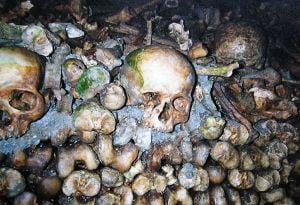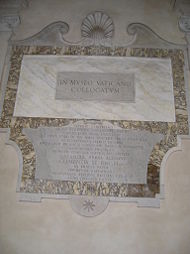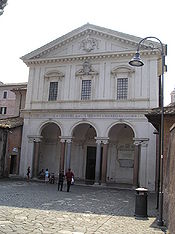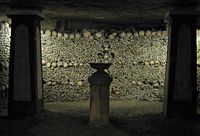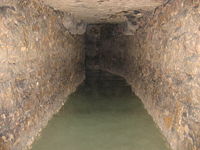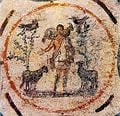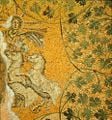Difference between revisions of "Catacomb" - New World Encyclopedia
Nick Perez (talk | contribs) |
|||
| Line 79: | Line 79: | ||
==Pop Culture== | ==Pop Culture== | ||
| − | Catacombs have long held the public imagination, and for good reason: long abandoned, hidden underground, dark, complex and full of dead bodies, catacombs naturally create a solemn, if not haunting, image in the mind. Authors and artists have realized this for a long time and have used catacombs for stories of macabre and terror. | + | Catacombs have long held the public imagination, and for good reason: long abandoned, hidden underground, dark, complex and full of dead bodies, catacombs naturally create a solemn, if not haunting, image in the mind. Authors and artists have realized this for a long time and have used catacombs for stories of macabre and terror. The most famous literary example may in fact be [[Edgar Allan Poe]]'s short story of 1846, "The Cask of Amontillado," in which the main character Montressor walls up another man inside a cavity, deep within some catacombs, which are described as being like the catacombs of Paris. In movies, such film as the cult classic ''Les Gaspards'', (known in English as ''The Holes''), and the 1989 film [[Indiana Jones and the Last Crusade]] both such catacombs as settings. |
| − | |||
| − | |||
| − | |||
| − | |||
| − | |||
| − | |||
| − | |||
| − | |||
| − | |||
| − | |||
| − | |||
| − | |||
| − | |||
| − | |||
| − | |||
| − | |||
| − | |||
| − | |||
| − | |||
| − | |||
==Gallery of paintings from the catacombs of Rome== | ==Gallery of paintings from the catacombs of Rome== | ||
Revision as of 18:45, 16 September 2007
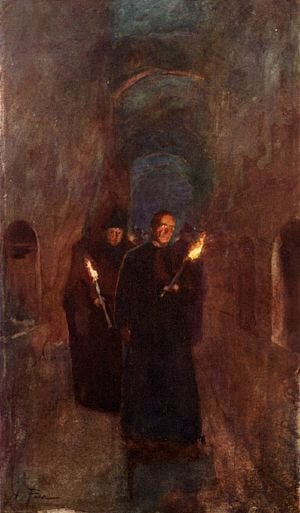
Catacombs refers to a network of underground burial galleries, the design of which originated in Ancient Rome. The word now refers to any network of caves, grottos, or subterranean place that is used for the burial of the dead, or it can refer to a specific underground burial place. Many older cities have such burial sites and archaeologists are careful to preserve such sites for they continue to capture the imagination of the public.
Etymology
The word catacomb derives from the Greek κατα (down) and τυμβος (tomb). Eventually, the word was incorporated into Latin as catacumbæ, which roughly translates as "among the tombs", and then into variations within the Romance Languages: catacomba in Italian, catacumba in Spanish, and catacombe in French. It is most likely that from the French version it was transfered into English, although linguists cannot be certain.[1]
While the word is most often used as a noun, years of literary usage and attention in public consciousness has also allowed the word to become an adjective, describing an underground area as having certain historical, and supernatural properties often associated with catacombs.
Description

While there are many cultural variations on the structural design of catacombs, there are some basic generalities to all such sites. They are almost always built underground, usually below an either pre-existing or still inhabited large metropolitan area. Often they are carved out of bedrock, although sometimes materials are imported externally in the construction. Catacombs often consist of long, narrow passage ways with galleries, large inbuilt shelving units that hold exposed remains. At other times, the dead are entombed in vaults or chambers, sealed off from the main corridors. Usually such designs were left for people of great importance or the wealthy, while the lower classes were simply placed on top of each other in galleries. Certain catacombs are designed almost as aqueducts, so that water flows in channels under the floor. There is often no ventilation or lighting systems in the catacombs, creating a toxic and dangerous environment and the cause for many of the popular stories of catacombs being haunted and of supernatural significance.
Roman Catacombs
The first catacombs constructed in the world are the ancient Jewish and Christian underground burials in Rome, often referred to as the San Sebastiano fuori le mura. The first large-scale catacombs were constructed from the 2nd century onwards. The Etruscans used to bury their dead in underground chambers and early Christians revived the practice because they did not want to cremate their dead due to their belief in bodily resurrection. Hence they began to bury their dead, first in simple graves and sometimes in burial vaults of pro-Christian patricians. Originally they were carved through soft rock outside the boundaries of the city, because Roman law forbade burial places within city limits. At first they were used both for burial and the memorial services and celebrations of the anniversaries of Christian martyrs (following similar Roman customs).[2]. They probably were not used for regular worship. Many modern depictions of the catacombs show them as hiding places for Christian populations during times of persecution. This is unlikely, however, since the large numbers of decaying corpses would have made the air nearly (if not completely) toxic. Additionally, the general locations of the catacombs were known to the Roman officials, making them a poor choice for a secret hiding place.
There are forty known subterranean burial chambers in Rome. They were built along Roman roads, like the Via Appia, the Via Ostiense, the Via Labicana, the Via Tiburtina, and the Via Nomentana. Names of the catacombs – like St Calixtus and St Sebastian alongside Via Appia – refer to martyrs that might be buried there.
Christian excavators (fossors) built vast systems of galleries and passages on top of each other. They lie 7-19 meters (22-65 ft) below the surface in area of more than 2.4 km² (600 acres). Narrow steps that descend as many as four stories join the levels. Passages are about 2.5x1 meters (8x3 feet). Burial niches (loculi) were carved into walls. They are 40-60 cm (16-24 in) high and 120-150 cm (47-59 in) long. Bodies were placed in chambers in stone sarcophagi in their clothes and bound in linen. Then the chamber was sealed with a slab bearing the name, age and the day of death. Fresco decorations were typically Roman. The catacomb of Saint Agnes is a small church. Some families were able to construct cubicula which would house various loculi and the arquitectural elements of the space would be a support for decoration. Another excellent place for artistic programs were the arcosoliums.[3]
In 380, Christianity became a state religion. At first many still desired to be buried in chambers alongside martyrs. However, the practice of catacomb burial declined slowly, and the dead were increasingly buried in church cemeteries. In the 6th century catacombs were used only for martyrs’ memorial services. Apparently Ostrogoths, Vandals and Lombards that sacked Rome also violated the catacombs, possibly looking for valuables. By the 10th century catacombs were practically abandoned, and holy relics were transferred to above-ground basilicas. In the intervening centuries they remained forgotten until they were accidentally rediscovered in 1578, after which Antonio Bosio spent decades exploring and researching them for his volume, Roma Sotterranea (1632).
The catacombs have become an important monument of the early Christian church. Currently maintenance of the catacombs is in the hands of the Papacy which has invested the Salesians of Don Bosco the supervision of the Catacombs of St. Callixtus on the outskirts of Rome.
Catacombs of Paris
Most widely known as "the Paris catacombs," the Roman-era limestone quarries that were converted into a mass tomb near the end of the 18th century is official known as "les carrières de Paris" or "the quarries of Paris."
The use of the depleted quarries for the storage of bones was established in 1786 by the order of Monsieur Thiroux de Crosne, Lt. General of Police, and by Monsieur Guillaumot, Inspector General of Quarries. At the time, the Les Halles district in the middle of the city was suffering from disease, due to contamination caused by improper burials and mass graves in churchyard graveyards especially the large Saints Innocents Cemetery. It was decided to discreetly remove the bones and place them in the abandoned quarries.
Remains from the cemetery of Saint-Nicolas-des-Champs were among the first to be moved. Bodies of the dead from the riots in the Place de Greve, the Hotel de Brienne, and Rue Meslee were put in the catacombs on August 28 and 29, 1788.
The tunnels have long been used by Parisians for more than just burial. Walls are covered in graffiti dating from the 18th century onwards, suggesting trespassers frequented the catacombs. In 1871 communards killed a group of monarchists in one chamber. During World War II, Parisian members of the French Resistance used the tunnel system. Also during this period, German soldiers established an underground bunker in the catacombs below Lycee Montaigne, a high school in the 6th arrondissement.[4]
Today, entrance to the catacombs is restricted. The portion of the catacombs open to the public is only a small part of an extensive network of underground tunnels, which spans more than 300km (about 186 miles) in length. The tunnel system is complex, and though some tunnels have plaques indicating the name of the street above, it is still quite easy to get lost: some passages are extremely low or narrow and others are partially flooded. There are also aging telephone wires, pipes, etc. that can hinder progress, and cave-ins, although rare, do occasionally occur. A good guide is therefore indispensable, and even many good guides still refer to a map from time to time. Because of these potential dangers, accessing the catacombs unescorted by officials has been illegal since November 2, 1955. Even with such restrictions, the catacombs pose problems, particularly with new construction in the city. Quarries sometimes cave in, occasionally resulting in a hole in the ground above and causing damage to buildings. This had led to strict regulations regarding all new construction and maintenance of the metro line and sewer system in the city.
Capuchin catacombs of Palermo
The Capuchin catacombs of Palermo are burial catacombs in Palermo, Sicily, southern Italy. Today they provide a somewhat macabre tourist attraction as well as an extraordinary historical record. Palermo's Capuchin monastery outgrew its original cemetery in the 16th century and monks begun to excavate crypts below it. In the 1599 they mummified one of their number, recently-dead brother Silvestro of Gubbio, and placed him into the catacombs.
The bodies were dehydrated on the racks of ceramic pipes in the catacombs and sometimes later washed with vinegar. Some of the bodies were embalmed and others enclosed in sealed glass cabinets. Monks were preserved with their everyday clothing and sometimes with ropes they had worn as a penance.
Originally the catacombs were intended only for the dead friars. However, in the following centuries it became a status symbol to be entombed into the capuchin catacombs. In their wills, local luminaries would ask to be preserved in certain clothes, or even to have their clothes changed at regular intervals. Priests wore their clerical vestments, others were clothed according to the contemporary fashion. Relatives would visit to pray for the deceased and also to maintain the body in presentable condition. The catacombs were maintained through the donations of the relatives of the deceased. Each new body was placed in a temporary niche and later placed into a more permanent place. As long as the contributions continued, the body remained in its proper place but when the relatives did not send money any more, the body was put aside on a shelf until they continued to pay.[5]
The last friar interred into the catacombs was Brother Riccardo in 1871 but other famous people were still interred. The catacombs were officially closed for use in 1880 but tourists continued to visit them. However, the last burials are from the 1920s. One of the very last to be interred was Rosalia Lombardo, then two years old, whose body is still remarkably intact, preserved with a procedure now lost: the embalmer, Professor Alfredo Salafia took his method with him to his grave.[6]
The catacombs contain about 8000 mummies that line the walls. The halls are divided into categories: Men, Women, Virgins, Children, Priests, Monks, and Professionals. Some bodies are better preserved than others. Some are set in poses: for example, two children are sitting together in a rocking chair.
Famous people buried in the catacombs include:
- Colonel Enea DiGuiliano (in French Bourbon uniform)
- Salvatore Manzella, surgeon
- Lorenzo Marabitti, sculptor
- Filipo Pennino, sculptor
- Son of a king of Tunis who had converted to Catholicism
- Allegedly Velasquez, Spanish painter, although his grave is officially unknown
Other Catacombs
There are catacomb-like burial chambers throughout the world, ranging from such places as Anatolia, Turkey, Susa, North Africa, Naples, Italy; in Syracuse, Italy; Trier, and Germany. In Ukraine and Russia, catacomb (used in the local languages' plural katakomby) also refers to the network of abandoned caves and tunnels earlier used to mine stone, especially limestone. Such catacombs are situated in Crimea and the Black Sea coast of these two countries. The most famous are catacombs beneath Odessa and Ajimushkay, Crimea, Ukraine. In the early days of Christianity, believers conducted secret worship services in these burial caves for safety and reverence for the dead. Later, they served as bases for Soviet World War II guerrillas (see also Great Patriotic War). Ajimushkay catacombs hosted about 10,000 fighters and refugees.
Pop Culture
Catacombs have long held the public imagination, and for good reason: long abandoned, hidden underground, dark, complex and full of dead bodies, catacombs naturally create a solemn, if not haunting, image in the mind. Authors and artists have realized this for a long time and have used catacombs for stories of macabre and terror. The most famous literary example may in fact be Edgar Allan Poe's short story of 1846, "The Cask of Amontillado," in which the main character Montressor walls up another man inside a cavity, deep within some catacombs, which are described as being like the catacombs of Paris. In movies, such film as the cult classic Les Gaspards, (known in English as The Holes), and the 1989 film Indiana Jones and the Last Crusade both such catacombs as settings.
Gallery of paintings from the catacombs of Rome
Notes
- ↑ The Oxford English Dictionary (Oxford Press, 1971). ISBN 019861117X
- ↑ (2005) Instituto Salesiamo San Callisto-Roma ["The Christian Catacombs of Rome"] Retrieved September 6, 2007
- ↑ Rossi, Giovanni. "Roma Sotterranea or Some Account of the Roman Catacombs Especially of the Cemetry of San Callisto" (Kessinger Publishing 2005) ISBN 1417974184
- ↑ (2007) Solis, Julia. National Geographic Explorer. ["Paris' Urban Underground"] Retrieved September 6, 2007
- ↑ (2007) King, Kimberly.["KING'S CAPUCHINS' CATACOMBS OF PALERMO ITALY"] Retrieved September 6, 2007
- ↑ (2007)Kilpatrick, Nancy and Hugues Leblanc. Hidden Mysteries, The Weird, The Unexplained ["The Capuchin Cemetery and Catacombs of Palermo"] Retrieved September 6, 2007
ReferencesISBN links support NWE through referral fees
- Adams, W. H. Davenport. 2003. Famous Caves and Catacombs: Described and Illustrated. Kessinger Publishing. ISBN 0766159507
- Kip, William Ingraham. 2005. The Catacombs of Rome: As Illustrating the Church of the First Three Centuries. Kessinger Publishing. ISBN 141796331X
- Nicolai, Vincenzo Fiocchi, Fabrizio Bisconti, and Danilo Mazzoleni. 2006. The Christian Catacombs of Rome: History, Decoration, Inscriptions. Schnell & Steiner. ISBN 3795411947
- Rossi, Giovanni. 2005. Roma Sotterranea or Some Account of the Roman Catacombs Especially of the Cemetry of San Callisto. Kessinger Publishing. ISBN 1417974184
External links
- About the Roman Catacombs
- Catacombe Roma
- Rodolpho Lanciani, Pagan and Christian Rome 1892, Chapter VII: Christian Cemeteries
- Rome Catacombs
- The Catacombs of St Callixtus
- (English) Explographies.com : Catacombs of Paris - Cartography, maps & plans of the catacombs and underground quarries
- (English) Underground Paris—A Paris Catacombs virtual tour with photos
- (French) History and information on unofficial visits
- (English) Urban-Resources
- (English) La Mexicaine De Perforation
- (English) Urbanadventure—Information source on the catacombs with images, videos and maps
- (English) Zone Tour—Database of Urban Exploration
- (French) Cyber Kata—List of links to various sites about urban exploration
- (French) Comperes Exploration—Pics and reports of a french ubran exploration team.
- (English) Catacombs of Paris—some useful information, description, links
- (English) "A tour of the dark world beneath the city of lights" by Murray Battle
- (French) Official website, opening hours, entrance fees
- (English) www.Guerillaphotography.co.uk - Urban exploration site with a tour of the catacombs and a write-up
- (English) The Parisian Underworld impressions of a visiting American student
- Paolo Ventura - Dressed for Eternity
- Athanasius Kircher Society about the catacombs
- King's Capuchin Catacombs of Palermo
- Tourist information about the catacomps in Whatsonwhen
- Paradoxplace Catacombe Cappuccini Page
Credits
New World Encyclopedia writers and editors rewrote and completed the Wikipedia article in accordance with New World Encyclopedia standards. This article abides by terms of the Creative Commons CC-by-sa 3.0 License (CC-by-sa), which may be used and disseminated with proper attribution. Credit is due under the terms of this license that can reference both the New World Encyclopedia contributors and the selfless volunteer contributors of the Wikimedia Foundation. To cite this article click here for a list of acceptable citing formats.The history of earlier contributions by wikipedians is accessible to researchers here:
- Catacombs history
- Catacombs_of_Rome history
- Catacombs_of_Paris history
- Capuchin_catacombs_of_Palermo history
The history of this article since it was imported to New World Encyclopedia:
Note: Some restrictions may apply to use of individual images which are separately licensed.
